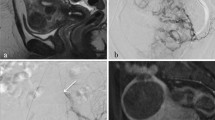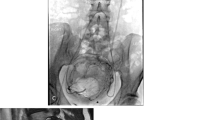Abstract
Objective
To evaluate effectiveness and safety of UFE as alternative to surgery, in treatment of uterine fibromatosis.
Methods/materials
255 patients (aged 26–55) with symptomatic UF, indication for surgery, followed in our center (2000–2014), single or multiple fibroids, pain and/or functional/compressive disorders, underwent embolization: injection of PVA particles (150–900 μm) from distal portion of uterine arteries (ascending section). Primary end-point: flow-stop distally to injection site, disappearance of lesion design, preservation of flow in main trunk of UA. Secondary end-point: control of pain and functional/compressive disorders during follow-up (2–7 years).
Results
Procedure was performed bilaterally in 250 patients (98%). Mean duration: 47 min (average fluoroscopy: 10:50 min). Post-embolization pelvic pain (according with VAS score) was on average 2.2 at discharge (24 h). Follow-up at 2 years: resolution of menstrual disorders in 78% of patients and improvement in 14%; pain disappeared in 66%; significant improvement of menstrual flow and HCT/HB levels, decrease in total uterine (57.7%)/dominant fibroid (76.1%) volume. Recurrence in 18 patients.
Conclusions
UFE represents an excellent alternative to surgical treatment: it is safe, tolerable and effective both in short and long term, with evident advantages in economic and social terms.







Similar content being viewed by others

Abbreviations
- CI:
-
Confidence interval
- FSH:
-
Follicle-stimulating hormone
- HR:
-
Hazard ratio
- HRT:
-
Hormone replacement therapy
- LH:
-
Luteinizing hormone
- MRI:
-
Magnetic resonance imaging
- NSAID:
-
Non-steroidal anti-inflammatory drugs
- PVA:
-
Polyvinyl alcohol
- SD:
-
Standard deviation
- UFE:
-
Uterine fibroid embolization
- VAS:
-
Visual analogue scale
References
Pron G et al (2003) Tolerance, hospital stay, and recovery after uterine artery embolization for fibroids: the Ontario Uterine Fibroid Embolization Trial. JVIR 14(10):1234–1250
Goodwin SC et al (2001) Uterine artery embolization for uterine fibroids: a radiologist’s perspective. Clin Obstet Gynecol 44(1):412–424
Bruno J et al (2004) Recovery after uterine artery embolization for leiomyomas: a detailed analysis of its duration and severity. JVIR 15:801–807
Edwards RD et al (2007) Committee of the Randomized Trial of Embolization versus Surgical Treatment for Fibroids. Uterine-artery embolization versus surgery for symptomatic uterine fibroids. N Engl J Med 356(4):360–370
Spies JB et al (2001) Uterine artery embolization for leiomyomata. Obstet Gynecol 98:29–34
Worthington-Kirsch R et al (2005) The Fibroid Registry for outcomes data (FIBROID) for uterine embolization short-term outcomes. Obstet Gynecol 106(1):52–59
Goodwin SC et al (2006) Uterine artery embolization versus myomectomy: a multicenter comparative study. Fertil Steril 85:14–20
Farquhar CM et al (2002) Hysterectomy rates in the United States 1990–1997. Obstet Gynecol 99(2):229–234
Levy BS (2008) Modern management of uterine fibroids. Acta Obstet Gynecol Scand 87(8):812–823
McLucas B et al (2001) Uterine fibroid embolization: nonsurgical treatment for symptomatic fibroids. J Am Coll Surg 192:95–105
Walker WJ, Pelage JP (2002) Uterine artery embolisation for symptomatic fibroids: clinical results in 400 women with imaging follow-up. Br J Obstet Gynecol 109:1263–1272
Pron G et al (2003) The Ontario Uterine Fibroid Embolization Trial. Part 2. Uterine fibroid reduction and symptom relief after uterine artery embolization for fibroids. Fertil Steril 79:120–127
Spies JB et al (2005) The FIBROID Registry: symptom and quality-of-life status 1 year after therapy. Obstet Gynecol 106:1309–1318
Badawy SZ et al (2001) Uterine artery embolization: the role in obstetrics and gynecology. Clin Imaging 25:288–295
Hutchins FL Jr et al (1999) Selective uterine artery embolization as primary treatment for symptomatic leiomyomata uteri. J Am Assoc Gynecol Laparosc 6:279–284
Huang JY et al (2006) Failure of uterine fibroid embolization. Fertil Steril 85(1):30–35
Volkers NA et al (2007) Uterine artery embolization versus hysterectomy in the treatment of symptomatic uterine fibroids: 2 years’ outcome from the randomized EMMY trial. Am J Obstet Gynecol 196(6):519.e1–519.e11
Park HR et al (2005) Uterine restoration after repeated sloughing of fibroids or vaginal expulsion following uterine artery embolization. Eur Radiol 15:1850–1854
Spies JB et al (2005) Long-term outcome of uterine artery embolization of leiomyomas. Obstet Gynecol 106:933–939
Katsumori T et al (2006) Long-term outcomes of uterine artery embolization using gelatine sponge particles alone for symptomatic fibroids. AJR 186:848–854
Goodwin SC et al (2008) Uterine artery embolization for treatment of leiomyomata. Long-term outcomes from the FIBROID Registry. Obstet Gynecol 111:22–33
van der Kooij SM et al (2010) Uterine artery embolization vs hysterectomy in the treatment of symptomatic uterine fibroids: 5-year outcome from the randomized EMMY trial. Am J Obstet Gynecol 203(2):105.e1–105.e13
Spies JB et al (2002) Complications after uterine artery embolization for leiomyomas. Obstet Gynecol 100(5):874–880
Marret H et al (2003) Leiomyoma recurrence after uterine artery embolization. J Vasc Interv Radiol 14:1395–1400
Pelage JP et al (2004) Uterine fibroid tumors: long-term MR imaging outcome after embolization. Radiology 230(3):803–809
Spies JB et al (2002) Leiomyomata treated with uterine artery embolization: factors associated with successful symptom and imaging outcome. Radiology 222(1):45–52
Marret H et al (2005) Predictive factors for fibroids recurrence after uterine artery embolisation. BJOG 112(4):461–465
Huang JY et al (2006) Failure of uterine fibroid embolization. Fertil Steril 85:30–35
Gabriel-Cox K et al (2007) Predictors of hysterectomy after uterine artery embolization for leiomyoma. Am J Obstet Gynecol 196:588.e1–588.e16
Lohle PN et al (2008) Long-term outcome of uterine artery embolization for symptomatic uterine leiomyomas. J Vasc Interv Radiol 19(3):319–326
Toor SS et al (2008) Clinical failure after uterine artery embolization: evaluation of patient and MR imaging characteristics. J Vasc Interv Radiol 19(5):662–667
Bonney V (1931) The tecnique and results of myomectomy. Lancet 220:171–173
Yoo EH et al (2007) Predictors of leiomyomata recurrence after laparoscopic myomectomy. J Minim Invasive Gynecol 14(6):690–697
Reed SD et al (2006) The incidence of repeat uterine surgery following myomectomy. J Womens Health 15(9):1046–1052
Goodwin S et al (1999) Uterine artery embolization for the treatment of uterine leiomyomata: mid-term results. J Vasc Inter Radiol 10:1159–1165
Pelage JP et al (2005) Uterine fibroid vascularization and clinical relevance to uterine fibroid embolization. Radiographics 25(Suppl 1):S99–S117
Payne JF et al (2003) Serious complications after uterine embolization for conservative treatment of fibroids. Fertil Steril 79(1):128–131
Sawin SW et al (2000) Comparability of perioperative morbidity between abdominal myomectomy and hysterectomy for women with uterine leiomyomas. Am J Obstet Gynecol 183:1448–1455
Marret H et al (2004) Late leiomyoma expulsion after uterine artery embolization. J Vasc Interv Radiol 15:1483–1485
Are F (2008) Fibroids that become endocavitary after uterine artery embolization necessarily a complication? AJR Am J Roentgenol 190(5):1227–1230
Radeleff B et al (2010) Expulsion of dominant submucosal fibroids after uterine artery embolization. Eur J Radiol 75:e57–e63
Andrews RT et al (2004) Patient care and uterine artery embolization for leiomyomata. J Vasc Interv Radiol 15:115–120
Katsumori T et al (2005) Uterine artery embolization for pedunculated subserosal fibroids. AJR Am J Roentgenol 184:399–402
Margau R et al (2008) Outcomes after uterine artery embolization for pedunculated subserosal leiomyomas. J Vasc Interv Radiol 19:657–661
Smeets AJ et al (2009) Safety and effectiveness of uterine artery embolization in patients with pedunculated fibroids. JVIR 20:1172–1175
Andrews RT, Brown PH (2000) Uterine arterial embolization: factors influencing patient radiation exposure. Radiology 217:713–722
White AM et al (2007) Patient radiation exposure during uterine fibroid embolization and the dose attributable to aortography. J Vasc Interv Radiol 18:573–576
Nikolic B et al (2000) Patient radiation dose associated with uterine artery embolization. Radiology 214:121–125
Tse G, Spies JB (2010) Radiation exposure and uterine artery embolization: current risks and risk reduction. Tech Vasc Interv Radiol. 13(3):148–153
Nishizawa K et al (2008) Surface dose measurement in patients and physicians and effective dose estimation in patients during uterine artery embolisation. Radiat Prot Dosim 128:343–350
Spies JB et al (2001) Ovarian function after uterine artery embolization for leiomyomata: assessment with use of serum follicle stimulating hormone assay. J Vasc Interv Radiol 12:437–442
McLucas B et al (2001) Pregnancy following uterine fibroid embolization. Int J Gynaecol Obstet 74:1–7
Chrisman HB et al (2000) The impact of uterine fibroid embolization on resumption of menses and ovarian function. J Vasc Interv Radiol 11:699–703
Tulandi T et al (2002) Ovarian reserve after uterine artery embolization for leiomyomata. Fertil Steril 78:197–198
Payne JF et al (2002) Embolic microspheres within ovarian arterial vasculature after uterine artery embolization. Obstet Gynecol 100(5 Pt 1):883–886
Ahmad A et al (2002) Uterine artery embolization treatment of uterine fibroids: effect on ovarian function in younger women. J Vasc Interv Radiol 13:1017–1020
Healey S et al (2004) Ovarian function after uterine artery embolization and hysterectomy. J Am Assoc Gynecol Laparosc 11:348–352
Hovsepian DM et al (2006) A prospective comparison of the impact of uterine artery embolization, myomectomy, and hysterectomy on ovarian function. J Vasc Interv Radiol 17:1111–1115
Hehenkamp WJ et al (2007) Loss of ovarian reserve after uterine artery embolization: a randomized comparison with hysterectomy. Hum Reprod 22:1996–2005
Tropeano G et al (2010) Long-term effects of uterine fibroid embolization on ovarian reserve: a prospective cohort study. Fertil Steril 94(6):2296–2300
Tropeano G et al (2011) The timing of natural menopause after uterine fibroid embolization: a prospective cohort study. Fertil Steril 96(4):980–984
Tropeano G et al (2003) Permanent amenorrhea associated with endometrial atrophy after uterine artery embolization for symptomatic fibroids. Fertil Steril 79(1):132–135
Davies C et al (2002) Amenorrhea secondary to endometrial ablation and Asherman’s syndrome following uterine artery embolization. Clin Radiol 54:317–318
Mara M et al (2007) Hysteroscopy after uterine fibroid embolization in women of fertile age. J Obstet Gynaecol Res 33:316–324
Mara M et al (2012) Hysteroscopy after uterine fibroid embolization: evaluation of intrauterine findings in 127 patients. J Obstet Gynaecol Res 38:823–831
Ravina JH et al (2000) Pregnancy after embolization of uterine myoma: report of 12 cases. Fertil Steril 73(1241):1243
Pron G, Ontario UFE Collaborative Group et al (2005) Pregnancy after uterine artery embolization for leiomyomata: the Ontario multicenter trial. Obstet Gynecol 105(67):76
Walker WJ, McDowell SJ (2006) Pregnancy after uterine artery embolization for leiomyomata: a series of 56 completed pregnancies. Am J Obstet Gynecol 195:1266–1271
Holub Z et al (2008) Pregnancy outcomes after uterine artery occlusion: prospective multicentric study. Fertil Steril 90(5):1886–1891
Pabon PI et al (2008) Pregnancy after uterine fibroid embolization: follow-up of 100 patients embolized using tris-acryl gelatin microspheres. Fertil Steril 90(6):2356–2360
Pisco JM et al (2011) Pregnancy after uterine fibroid embolization. Fertil Steril 95(3):1121.e5–1121.e8. https://doi.org/10.1016/j.fertnstert.2010.08.032 (epub 2010 Sep 25)
Funding
The authors state that this work has not received any funding.
Author information
Authors and Affiliations
Corresponding author
Ethics declarations
Guarantor
The scientific guarantor of this publication is Alessandro Cina, MD.
Conflict of interest
The authors of this manuscript declare no relationships with any companies, whose products or services may be related to the subject matter of the article.
Statistics and biometry
One of the authors has significant statistical expertise. The study is on human subjects.
Informed consent
Written informed consent was not required by the Institutional Review Board for this study because it is a retrospective study.
Ethical approval
Institutional Review Board approval was not required because is a retrospective study.
Methodology
Retrospective, observational, performed at one institution.
Rights and permissions
About this article
Cite this article
Di Stasi, C., Cina, A., Rosella, F. et al. Uterine fibroid embolization efficacy and safety: 15 years experience in an elevated turnout rate center. Radiol med 123, 385–397 (2018). https://doi.org/10.1007/s11547-017-0843-6
Received:
Accepted:
Published:
Issue Date:
DOI: https://doi.org/10.1007/s11547-017-0843-6



